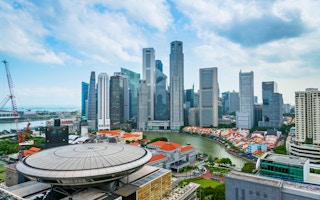Singapore’s Building and Construction Authority (BCA) on Friday launched a new set of guidelines to help commercial building owners and their tenants improve their sustainable green building practices.
To continue reading, subscribe to Eco‑Business.
There's something for everyone. We offer a range of subscription plans.
- Access our stories and receive our Insights Weekly newsletter with the free EB Member plan.
- Unlock unlimited access to our content and archive with EB Circle.
- Publish your content with EB Premium.
The government agency aims to promote the concept of ‘green lease’ agreements, which is about enabling landlords and tenants to work together on increasing energy efficiency, water efficiency and other measures that will make a building more sustainable. This new guidelines will also help improve transparency and accountability between building owners and tenants.
Second Minister for the Environment and Water Resources and Foreign Affairs Grace Fu launched the new ‘green lease’ toolkit during the Green Building Exhibition, which was held at Singapore’s Marina Square on Friday until Sunday.
Singapore is currently working on its 3rd Green Building Masterplan, which places people at the heart of the sustainable building agenda and the ‘green lease’ agreement is one way to engage landlords and tenants to collaborate on managing buildings sustainably, Fu told industry professionals during her speech.
“
Buildings exist to serve human activity and we need the stakeholders of the building to play a collective role in creating a positive work, live and play environment even as we conserve resources. One of the key thrusts is to foster greater collaboration and engagement with building occupants, landlords and tenants, as their activities contribute significantly to their buildings’ energy and water usage
Grace Fu, Second Minister for the Environment and Water Resources and Foreign Affairs
“Buildings exist to serve human activity and we need the stakeholders of the building to play a collective role in creating a positive work, live and play environment even as we conserve resources. One of the key thrusts is to foster greater collaboration and engagement with building occupants, landlords and tenants, as their activities contribute significantly to their buildings’ energy and water usage,” she explained.
With the green lease toolkit, BCA said it hopes to aid landlords and tenants to come together to holistically implement ways they can green their buildings over the entire life cycle of the building.
The toolkit provides a ‘green lease schedule’, which features a scheduling format that can be edited and adapted for use in a green lease agreement. It serves as a guideline for landlords and tenants on how to set their targets and monitor their performance in a more transparent manner.
A ‘Green Office Schedule’ and ‘Green Retail Schedule’ will also be available for download from the BCA website, the agency said in a document.
The building management or owners and the occupants could work together to monitor and improve energy efficiency, water efficiency, indoor air quality, sustainable forms of transportation, material and waste management by specifying their targets and setting the procedures on how to implement their environmental commitments, BCA said.
BCA also outlined the three ways building owners and occupants can start and move forward with their green lease programme:
- The first is through a Memorandum of Understanding or Agreement where both parties would commit to improve their environmental performance and an agreement to set the criteria against which performance will be measured. It may also include joint management plans for energy, water and waste.
- Meanwhile, the green lease schedule opens an opportunity for landlords and tenants to mutually disclose their environmental performance. The data collected can be used for the next level which is the ‘mutual performance’ green lease schedule. Meeting the targets set through this commitment are based on mutual disclosing and monitoring of performance. Incentives can be used for tenants to meet the performance targets.
- A ‘hard’ green lease, on the other hand, includes the environmental performance requirements as part of the normal lease framework. It also identifies responsibilities and financial obligations related to occupying and owning a green building and are explicit within the building lease.
BCA found that tenants generally consume about 50 per cent of the energy in commercial buildings, based on the agency’s past studies on Green Mark buildings and data collected through its Building Energy Submission System. Thus, owners and tenants have equal responsibility to collaborate on improving the building’s environmental performance, the agency said.










